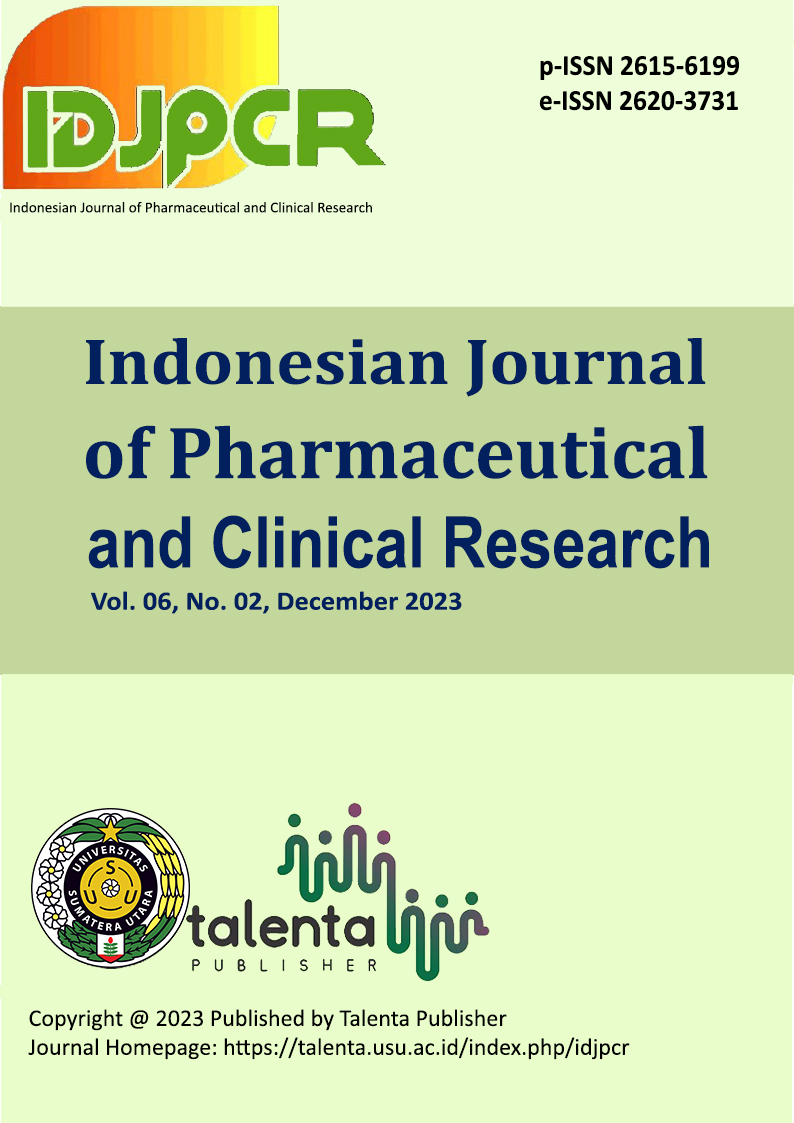Preparation and Evaluation of Polyherbal Face Pack
DOI:
https://doi.org/10.32734/idjpcr.v6i2.14707Abstract
It is believed that Queen Cleopatra, the Egyptian goddess of beauty, used donkey milk in her baths to maintain her youthful appearance. Herbs are known to benefit the skin by providing a natural glow and softness, cleansing dead cells, and promoting the regeneration of new cells. This study aims to prepare polyherbal face packs (F1-F4) using natural ingredients such as turmeric, neem, orange peel, multani mitti, gram flour, rose petals, sandalwood, rice flour, and aloe Vera. The polyherbal face packs (F1-F4) were evaluated based on organoleptic properties, physicochemical parameters (loss on drying, ash content, and pH), rheological properties (angle of repose, Hausner’s ratio, Carr’s index, bulk and tapped density) and spreadability. The evaluation results showed that the all polyherbal face packs had favourable physicochemical and rheological properties and spreadability. This study successfully prepared and evaluated polyherbal face packs (F1-F4) using a combination of natural ingredients known for their skin benefits, such as turmeric, neem, orange peel, multani mitti, gram flour, rose petals, sandalwood, rice flour, and aloe vera. The face packs were subjected to a comprehensive set of tests to assess their suitability for cosmetic use.
Downloads
References
https://organiko.in/blogs/new-blog/ancient-egyptian-beauty-secret-in-india.
Thanya Promsor. Development of Herbal Facial Mask Cream from Suan Sunandha Palace Facial Beauty. International Journal of Advances in Science Engineering and Technology. 2017;5(1):23-26.
Sabmanee C. “Research Development Production and Verify Herbal Extractâ€, Research Institute of Science and Technology, Thailand, 2006.
Karen J. Carlson (1996). The Harvard Guide to Women's Health. Harvard University Press. p. 574.
Okereke JN, Udebuani AC, Ezeji EU, Obasi KO, Nnoli MC. Possible health implications associated with cosmetics: A review. Sci J Public Health 2015; 3:58-3.
Lupo MP. Antioxidants and vitamins in cosmetics. Clin Dermatol 2001; 19:467-73.
Sowmya KV, Darsika CX, Grace F, Shanmuganathan S. Formulation and evaluation of poly-herbal face wash gel. World J Pharm Pharm Sci 2015; 4:585-8.
Millikan LE. Cosmetology, cosmetics, cosmeceuticals: Definitions and regulations. Clin Dermatol 2001; 19:371-4.
Rubia C.G. Correa, Rosane M. Peralta, Charles WI Haminiuk, Giselle Maria Maciel, Adelar Bracht, Isabel CFR Ferreira. New Phytochemicals as potential human anti-aging compounds: reality, promise and challenges. Critical Reviews in food Sciences and Nutrition 2018; 58(6): 942-957.
https://www.healthline.com/health/beauty-skin-care/multani-mitti-for-face#benefits
Amalraj A, Piusb A, Gopib S, Gopia S. Biological activities of curcuminoids, other biomolecules from turmeric and their derivatives—A review. J Tradit Complement Med. 2016
https://www.kiehls.com/skincare-advice/turmeric-skin-benefits.html
Ammon HPT, Wahl MA. Pharmacology of Curcuma longa. Planta Med. 1990;57:1–7. doi: 10.1055/s-2006-960004.
Dixit VP, Jain P, Joshi SC. Hypolipidaemic effects of Curcuma longa L. and Nardostachys jatamansi, DC in triton-induced hyperlipidaemic rats. Indian J Physiol Pharmacol. 1988;32:299–304.
Huang MT, Lou YR, Ma W, Newmark HL, Reuhl KR, Conney AH. Inhibitory effects of dietary curcumin on forestomach, duodenal, and colon carcinogenesis in mice. Cancer Res. 1994; 54:5841–5847.
Panahi Y, Saadat A, Beiraghdar F, Nouzari SMH, Jalalian HR, Sahebkar A. Antioxidant effects of bioavailability-enhanced curcuminoids in patients with solid tumors: a randomized double-blind placebo-controlled trial. J Funct Foods. 2014; 6:615–622. doi: 10.1016/j.jff.2013.12.008.
Rao CV, Rivenson A, Simi B, Reddy BS. Chemoprevention of colon carcinogenesis by dietary curcumin, a naturally occurring plant phenolic compound. Cancer Res. 1995; 55:259–266.
Ajay Kumar, Amit Kishore Singh, Manish Singh Kaushik, Surabhi Kirti Mishra, Pratima Raj, P.K Singh, K.D. Pandey. Interaction of turmeric (Curcuma longa L.) with beneficial microbes: a review. 3 Biotech.7 (6):357;2017.
Akihisa, T.; Takahashi, A.; Kikuchi, T.; Takagi, M.; Watanabe, K.; Fukatsu, M.; Fujita, Y.; Banno, N.; Tokuda, H.; Yasukawa, K. The melanogenesis-inhibitory, anti-inflammatory, and chemopreventive effects of limonoids in n-hexane extract of Azadirachta indica A. Juss. (Neem) Seeds. J. Oleo Sci. 2011, 60, 53–59.
Mohammad A. Alzohairy. Review article Therapeutics Role of Azadirachta indica (Neem) and their active constituents in disease prevention and treatment. Evid Based Complement Alternat Med. 2016: 1-13
Rahmani A. H., Alzohairy M. A., Khan M. A., Aly S. M. Therapeutic implications of black seed and its constituent thymoquinone in the prevention of cancer through inactivation and activation of molecular pathways. Evidence-Based Complementary and Alternative Medicine. 2014; 1-13.
Ilango K., Maharajan G., Narasimhan S. Anti-nociceptive and anti-inflammatory activities of Azadirachta indica fruit skin extract and its isolated constituent azadiradione. Natural Product Research. 2013;27(16):1463–1467.
Akter R., Mahabub-Uz-Zaman M., Rahman M. S., et al. Comparative studies on antidiabetic effect with phytochemical screening of Azadirachta indicia and Andrographis paniculata . IOSR Journal of Pharmacy and Biological Sciences. 2013;5(2):122–128.
Devmurari V. P., Jivani N. P. Hepatoprotective activity of methanolic and aqueous extracts of Azadirchata indica leaves. International Journal of PharmTech Research. 2010;2(2):1037–1040.
Atherton P. Aloe vera revisited. Br J Phytother. 1998; 4:76–83.
Shelton M. Aloe vera, its chemical and therapeutic properties. Int J Dermatol. 1991; 30:679–83. Atherton P. The essential Aloe vera: The actions and the evidence. 2nd ed 1997.
Hutter JA, Salmon M, Stavinoha WB, Satsangi N, Williams RF, Streeper RT, et al. Anti-inflammatory C-glucosyl chromone from Aloe barbadensis. J Nat Prod. 1996; 59:541–3.
Ishii Y, Tanizawa H, Takino Y. Studies of aloe. V: Mechanism of cathartic effect. Biol Pharm Bull. 1994;17:651–3.
Kim HS, Lee BM. Inhibition of benzo [a] pyrene-DNA adduct formation by aloe barbadensis Miller. Carcinogenesis. 1997;18:771–6.
West DP, Zhu YF. Evaluation of aloe vera gel gloves in the treatment of dry skin associated with occupational exposure. Am J Infect Control. 2003; 31:40–2.
Amar Surjushe, Resham Vasani, Saple DG. Aloe Vera: A Short Review. Indian J Dermatol. 2008;53(4):163-166
https://www.femina.in/beauty/benefits-of-gram-flour-for-skin-84681.html
https://pgshop.in/blog/11-amazing-skin-benefits-of-besan-3-simple-besan-face-packs-for-fair-skin/
https://www.bellchem.com/news/rice-flour-uses-in-skin-care-products
Piebiep Goufo, Henrique Trindade. Rice antioxidants: phenolic acids, flavonoids, anthocyanins, proanthocyanidins, tocopherols, tocotrienols, c-oryzanol, and phytic acid. Food Science & Nutrition, 2014; 2(2): 75– 104
S. Ochir, K. Ishii, B. Park et al., “Botanical origin of Mei-gui Hua (petal of a Rosa species),†Journal of Natural Medicines, vol. 64, no. 4, pp. 409–416, 2010.
R. Nowak, M. Olech, L Pecio et al., “Cytotoxic, antioxidant, antimicrobial properties and chemical composition of rose petals,†Journal of the Science of Food and Agriculture, vol. 94, no. 3, pp. 560–567, 2014.
A. Cendrowski, I. Ścibisz, M. Kieliszek, J. Kolniak-Ostek, and M. Mitek, “UPLC-PDA-Q/TOF-MS profile of polyphenolic compounds of liqueurs from Rose petals (Rosa rugosa),†Molecules, vol. 22, no. 11, article 1832, 2017.
https://mesmara.com/2019/08/31/uses-and-benefits-of-rose-petal-powder/
Concepción Sánchez-Moreno, M Pilar Cano, Begoña de Ancos, LucÃa Plaza, Begoña Olmedilla, Fernando Granado, Antonio MartÃn. Effect of orange juice intake on vitamin C concentrations and biomarkers of antioxidant status in humans, Am J Clin Nutr. 2003 Sep;78(3):454-60.
https://skinkraft.com/blogs/articles/fruits-to-eat-for-glowing-skin
Wijiastuti L. Antibacterial Activity of Sweet Orange Fruit Peel (Citrus sinensis (L) Osbeck) Against Staphylococcos aureus, Escherichia coli multi resistant and BSLT (In Bahasa Indonesia). Skripsi. Fakultas Farmasi, Universitas Muhammadiyah Surakarta, 2011.
Hegazy AE, Ibrahium MI. Antioxidant activities of orange peel extracts. World Appl Sci J. 2012;18(5):684–8.
Gil-Izquierdo A, Gil MI, Ferreres F, Tomas-Barberan FA. In vitro availability of flavonoids and other phenolics in orange juice. J Agric Food Chem. 2001;49(2):1035–41.
Doha H, Abou Baker, Bassant MM, Ibrahim, Yasmin Abdel Latif, Nabila S, Hassan, Emad M, Hassan, Souad El Gengaihi. Biochemical and Pharmacological prospects of Citrus sinensis peel. Heliyon; 2022; 8:1-14.
Farheen B, Mohammad I. Design and Development of Unani Face Pack For Skincare. European J Pharm Med Res 2016; 3(12): 627-632.
World Health Organisation. (1992). Pharmaceuticals Unit: Quality control methods for medicinal plant materials. Indian Standard, Face Pack-Specification, (2002) IS 15153.
Saxena PR, Pal Y, Wal P. 2017. In-House Preparation and Standardization of Herbal Face Pack. The Open Dermatology Journal, 11:72-80.
Himaja N, Ashok Kumar A, Bhart Kumar B. Preparation and evaluation of poly herbal fruit face mask. Quest Journals. Journal of Research in Pharmaceutical Science, 2015; 2(11):07-13
Anilkumar V, Kalyani R, Padmasri B, Prasanth D. In-house preparation, development and evaluation of herbal cosmetics face pack using various natural
powders. Journal of Drug Delivery and Therapeutics, 2020; 10(5):159-164.
Downloads
Published
How to Cite
Issue
Section
License
Copyright (c) 2023 Indonesian Journal of Pharmaceutical and Clinical Research

This work is licensed under a Creative Commons Attribution-ShareAlike 4.0 International License.
The Authors submitting a manuscript do so on the understanding that if accepted for publication, copyright of the article shall be assigned to Indonesian Journal of Pharmaceutical and Clinical Research (IDJPCR) and Faculty of Pharmacy as well as TALENTA Publisher Universitas Sumatera Utara as publisher of the journal.
Copyright encompasses exclusive rights to reproduce and deliver the article in all form and media. The reproduction of any part of this journal, its storage in databases and its transmission by any form or media, will be allowed only with a written permission from Indonesian Journal of Pharmaceutical and Clinical Research (IDJPCR).
The Copyright Transfer Form can be downloaded here.
The copyright form should be signed originally and sent to the Editorial Office in the form of original mail or scanned document.









